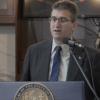Sussex buffers group kicks off meetings
Sussex County's Wetlands and Buffers Working Group got its feet wet at its first meeting Feb. 13.
The initial stakeholders' meeting offered an introduction to the goals of the group, which will meet over the six months to accomplish goals in two phases.
In Phase 1, the group will analyze county code definitions for wetlands, buffers and other waterways and recommend updates to code that balance environmental protection with property rights.
In Phase 2, the group will review regulations and determine if updates are needed to improve future land development.
The working group could recommend possible ordinances or amendments to Sussex County Council. Any changes would require public hearings before the planning and zoning commission and county council.
Recommendations could include changes to buffer widths and possible restrictions within a buffer.
“This is a topic in the past we've tried to talk about,” said Sussex County Administrator Todd Lawson. “We haven't had much success, but this is a different format including stakeholders with different interests.”
Councilman I.G. Burton, R-Lewes, who has pushed for updated buffer regulations, told the group that county council won't be involved. “We are looking forward to your input to us,” he said. “Everyone we asked to serve said yes, so that's a good sign we can have a good conversation.”
“The best minds in Sussex County are in this room. I have no doubt we can figure this out,” said group member and Sussex County Planning and Zoning Commission Chairman Bob Wheatley.
“This is the start of the mission to make improvements to county code,” Lawson said.
RK&K consultant Jim Eisenhardt said the county already has baseline information. “There has been a lot of good work done and a lot of effort to date. Our goal is to get to the finish line,” he said.
Eisenhardt said a good ordinance needs consistent wording, predictability and clarity. Assistant county attorney Vince Robertson said much of that is lacking in the current ordinance.
“We need to understand what is in the code to educate ourselves what changes are needed,” he said, adding good definitions are the foundation of an ordinance.
Group member and environmental consultant Ed Launay said he agreed the county needs updated definitions on tidal, or state-regulated, wetlands and waters and nontidal, or federal-regulated, wetlands and waters.
Eisenhardt said updating those definitions to provide predictability is the group's first task.
Group member Jay Baxter, a Georgetown-area farmer, asked why the group was reinventing the wheel when tidal wetlands were already regulated.
Eisenhardt said the state delineates wetlands but does not have buffer regulations; that's up to county officials. He said the ordinance should reflect what the county wants to do to protect water resources.
When member Rob Tunnell, partner with Tunnell Companies, asked if the group would discuss regulations regarding other buffers, Eisenhardt said the initial charge of the group is to address wetland and waterway buffers.
Wetlands maps are 30 years old
Eisenhardt said there is no plan to create a new regulatory program within county government. “The county will not hire wetlands scientists or staff to do wetlands delineations,” he said.
Currently, the county requires minimum 50-foot buffers from tidal wetlands and perennial streams and no buffers from nontidal wetlands.
Delaware Department of Natural Resources and Environmental Control maps outline the boundaries of state-regulated wetlands, but the maps have not been updated since 1988. Property owners can file appeals to make changes to the maps.
Group member Chris Bason, Center for the Inland Bays executive director, said one step the group could take is to make an official request that DNREC officials begin the process to update the maps.
The next meeting has been scheduled for 2 p.m., Wednesday, March 6, in the county west complex off Route 113. Meetings are open to the public, but no public comment will be accepted.
















































